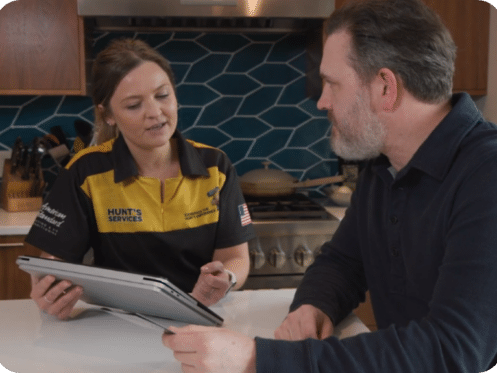Autumn’s chill is the first sign of fewer outdoor activities. That means you will rely on electric items and artificial light to entertain and complete tasks. While you prepare for cold weather, practice good habits to keep your energy bill low. These changes will not occur overnight. Repeated use of ideas coupled with one-time inspections and swaps will gradually decrease the bill.
1. The Thermostat
Roughly 50% of high energy bills are because of your HVAC system. Lower your thermostat temperature to a cool 68 degrees during the day. At night, turn it down even lower. Make up for it by adding thick bedding and wearing pajamas. Doing this reduces the electric bill by 10%.
Remembering to switch it low at night and high during the day will be difficult when you have other responsibilities. Therefore, it’s a perfect opportunity to upgrade to an HVAC-compatible version that will save energy. You can program it to a specific temperature at home and a lower temperature while you’re away. An HVAC technician will check your thermostat to see if the current one is fine or if an upgrade is necessary.
You can upgrade to programmable, smart, or Wi-Fi. The smart and Wi-Fi versions offer temperature modification through a smartphone app, no matter where you are.
Help keep bills low by keeping unoccupied rooms closed. Warm up the areas where people occupy the space. Don’t let heating ductwork enter those empty rooms.
2. Let Natural Light In
Windows facing the south or the east have the most natural light. When the sun is shining, turn off the heating unit and indoor lighting and open those windows. Close the curtains at night to keep the heat inside. Rely on indoor lighting for cloudy days and keep the window closed.
Meanwhile, the windows facing north are the coldest in the house. They should remain shut all autumn and winter to block the cold air outside.
3. Switch to Energy-Saving Lights
As you rely on artificial lighting to get through the day, stop using high-watt, hot-to-the-touch traditional bulbs. Instead, select low-watt LED bulbs for indoor, outdoor, and seasonal light decorations. They use less energy and last longer. The illumination is also just as bright as energy-draining traditional bulbs.
There are also lights with remote control or app-enabled dimmers that control brightness. Enjoy lower illumination for entertaining and higher illumination for tasks.
4. Seal Air Gaps
Air leaves through doors and windows the most; they also invite drafts into the home. That makes your heating unit work harder to warm up. Avoid this by sealing window cracks and gaps with moisture-proof caulking.
Cover the window with quilted curtains, thick drapes, window treatments, or vinyl shades with an insulation liner. Don’t use shutters and blinds during the autumn and winter months. The gaps in between them will let cool air in.
Use weatherstripping on doors that lead to the outdoors. Use a door snake, door sweep, or rolled-up fabric to cover the door bottom. Seal holes, cracks, and gaps in closets, walls, ceilings, attics, and basements with caulking. Avoid caulking in areas around the furnace pipe, water heater, or HVAC unit. Let an HVAC technician tackle air gaps around units and ductwork.
Air leaks exist around ductwork and recessed lights. Hire an HVAC technician to seal leaks around ductwork insulation. Contact an electrician to plug the gaps around recessed lighting.
Older homes have more gaps to seal up than newer homes due to wear and tear. Hire a home improvement expert to seal up holes and cracks in areas you missed and in dangerous sections like the roof and crawlspaces.
5. Get the Fireplace in Order
The fireplace is a source of heat loss in the home. Find the fireplace damper chain or lever and close it when you are not using it. Keep it permanently closed for fireplaces you will never use.
Add a chimney cap to keep animals and debris from entering the home. Use fireproof caulking to seal gaps, cracks, and holes in the firebox and hearth. Finish by closing the fireplace screen or glass doors.
The fireplace is not complete without a chimney examination. Hire a roofing expert to inspect and repair the chimney. That will stop drafts from coming inside. Hire a chimney sweeper to clean the soot inside the chimney entrance.
Open the damper, chimney cap, and screen or glass doors when you use the fireplace. Do not use your heating unit while the fireplace is on.
6. Refresh Insulation
About 50% of the air leaving the home is because of poor home insulation. The attic, crawlspace, wall, and flooring work better with fresh fiberglass or foam insulation. Rugs can also keep flooring insulated. Always contact professional technicians who specialize in home insulation. They know how to find, examine, remove, and add it to essential areas throughout your home.
7. Get an HVAC Tune-up
Hunt’s Services in Tacoma, WA wants your HVAC and furnace units operating in peak condition, and they can’t do that when they’re clogged or broken. Let our HVAC service technicians examine, diagnose, and repair the unit. We also clean the ducts, change the air filter, and remove dust and debris inside.
If it doesn’t work, we offer furnace replacement and HVAC installation services. We will select a suitable one based on budget and home size. We encourage customers to keep a routine maintenance schedule with us so their units stay in peak condition.
8. Turn Electronic Devices Off
Turn off electronics when no one is watching or listening to them. Examples are the TV, DVD/CD player, DVR, cable box, radio, stereo, video game console, and tablet. You find these devices in the living room, den, and bedroom.
Some devices connect to wall outlets. They drain more electricity from the home than a power strip or surge protector. Those devices use less energy and spread that energy across an entire group of plugged electronics. Another option is running battery-powered devices like wall clocks, laptops, and tablets.
The “always on” and “standby” buttons are red lights that tell you the electronic device is off. In reality, the red light is still using phantom energy. That means the devices use electricity when the electronic device is not in use.
In that instance, unplug those devices when you are not using them. Examples are phone and computer chargers. A second option is to turn off the power strip or surge protector switch and keep the cords plugged in. A third option is using a smart plug that turns on and off through a smartphone app.
9. Switch to Energy-Efficient Appliances
The oven, stove, dishwasher, refrigerator, washer, dryer, and microwave use the most energy in the house. Swapping them for energy-saving versions will cost more, but the savings earned on the bill will make up the difference. Appliances with the ENERGY STAR label do the same job efficiently while using less energy. The best time to grab them is when you need replacements. Another way to save energy is by unplugging kitchen countertop appliances when they are not in use.
Contact a Company With Multiple Skills Under One Roof
Hiring one company for plumbing, another for electricity, and a third for heating and cooling is stressful. You need a company that does all three. Hunt’s Services has electricians, plumbers, and technicians all under one roof. We use the latest technology and the most effective methods to solve your dilemma. We also fix sewer problems and improve air quality with whole-home filtration systems.
Contact Hunt’s Services online, in person, and by phone for more information.




